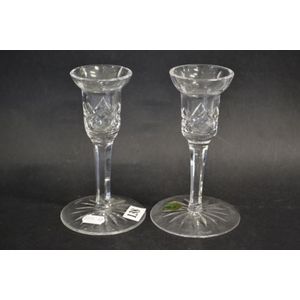Jacobite Sympathies Opaque Twist Stem Glass
You must be a subscriber, and be logged in to view price and dealer details.
Subscribe Now to view actual auction price for this item
When you subscribe, you have the option of setting the currency in which to display prices to $Au, $US, $NZ or Stg.
- Stem - In drinking glasses the stem is that section of the glass that joins the bowl to the foot. In mass produced glasses is usually solid and of cylindrical shape, but in antique drinking glasses it may be long and short and in various styles or with decoration, such as air twist, baluster, collared, faceted, hollow, knopped, teardrop, twisted or incised.
- Engraved Glass - The method of decorating glass by marking the surface with a sharp intrument such as a diamond, metal needle or rotating cutting wheel. As pressure is applied to the surface, best results for engraving are achieved if the glass is of sufficient thickness. In the 19th century etching was used to decorate some table glassware that was too fine to take an engraving tool.
- Jacobite - Wine glasses engraved with mottos and symbols of the Jacobites, who were supporters of Prince Charles Edward Stuart's claim to the English throne.
They were passed around amongst the members of secret groups devoted to the restoration of a Catholic monarch in Scotland and England under the House of Stuart.
The last Jacobite Rebellion ended with Charles Edward Stuart?s defeat at the Battle of Culloden in 1746. His image features on some of the Jacobite glassware.
Genuine examples of Jacobite glassware are dated between 1746 and 1788 but many later copies and forgeries are in circulation.
In November 2012 a Jacobite "Amen" glass, the rarest group of Jacobite glasses sold for £43,000 at auction in Shropshire, England. - Bowl - With drinking glasses, the bowl is the hollow section of the glass that holds the liquid. Many glasses were mounted on a stem joined to a foot, others were cylindrical, of tumbler shape. The size and shape of the bowl was determined by the type of liquids they were meant to hold. Shapes used included bell shaped, conical (funnel), bucket shaped, trumpet, cup, ogee, funnel, cylindrical and rounded.
- Twist - A rod of glass in which there is one or several threads or tapes of coloured glass, or bubbles of air embedded, which is then twisted to give an attractive appearance. The technique is mostly associated with the stems of Georgian glasses. The technique was in use from about the 1740s to the 1760s.
Collectors have identified over 150 variations of twist decoration. One of the most common is the air twist which as the name implies, has one or more columns of air embedded within the rod. A colour twist has one or more coloured tapes, usually opaque but sometimes translucent. other common types of twist include cable, corkscrew, enamel, gauze, lace, opaque and thread.
This item has been included into following indexes:
Visually similar items

Two Georgian wine glasses, circa 1765 and 1760 respectively, (2) the first having a pointed round funnel bowl, resting on a stem decorated with an opaque twist 12 ply spiral band outside a pair of tapes, terminating in a plain foot, the second having an en

Pair of Waterford Crystal candlesticks

A Georgian wine glass with an ogee bowl, engraved with flowers, and a double-twist stem on a folded foot

A Georgian glass with trumpet bowl, with air twist stem on folded foot, 16 cm high. Provenance: John Dixon Antiques, Auckland, New Zealand. The Estate of Stanley Crawford Stevens.
